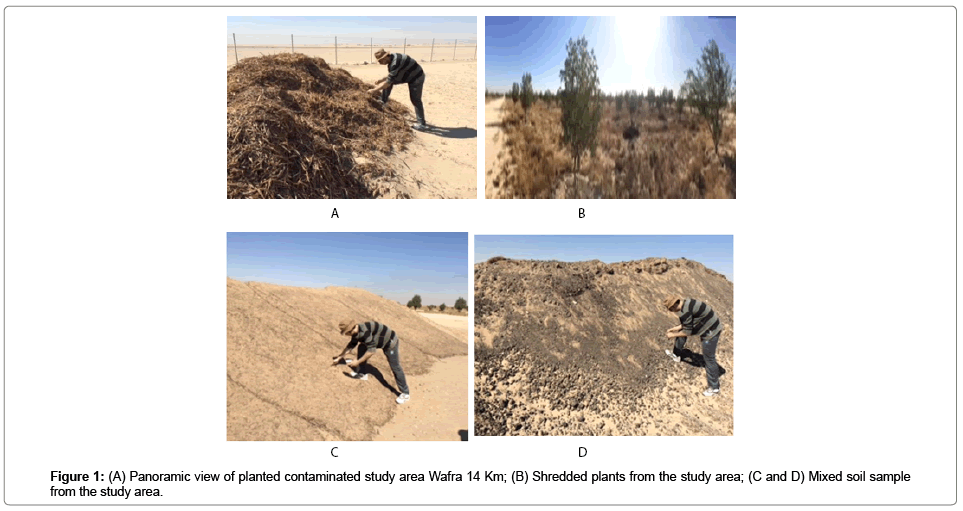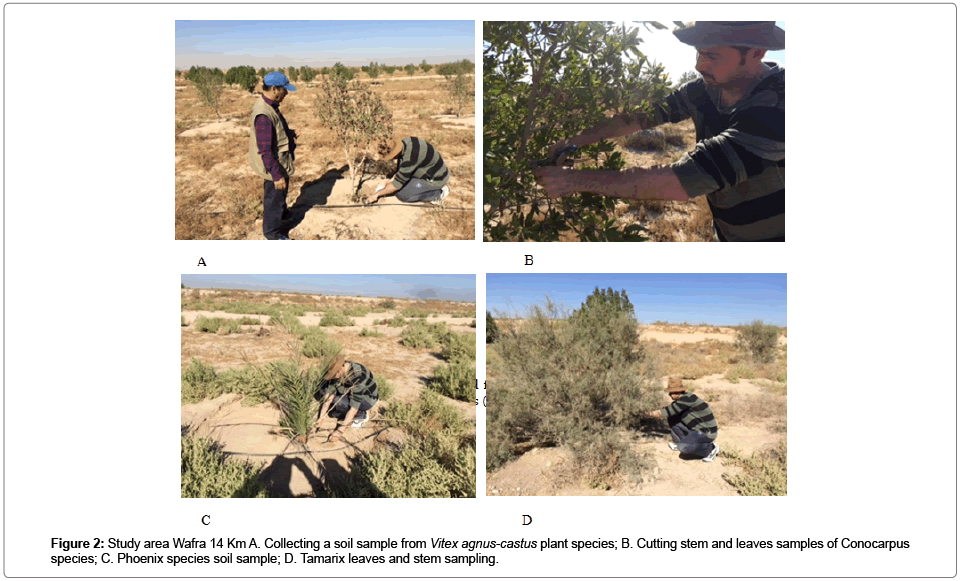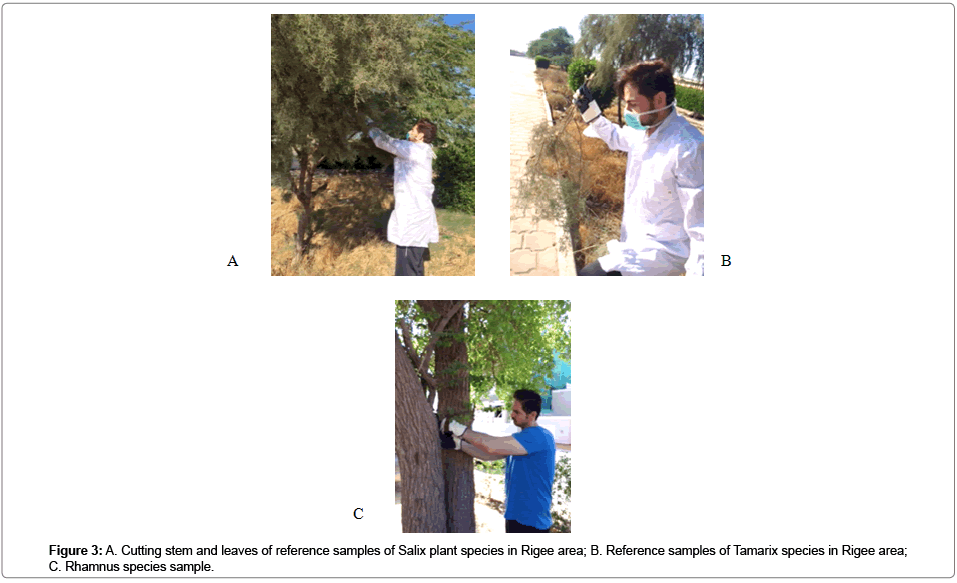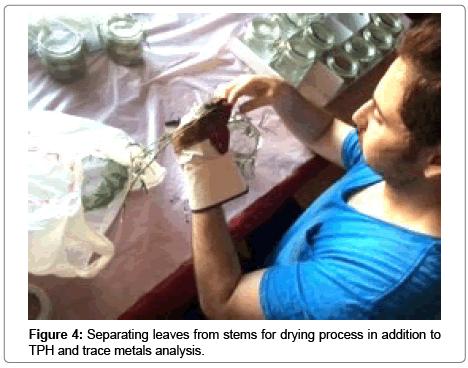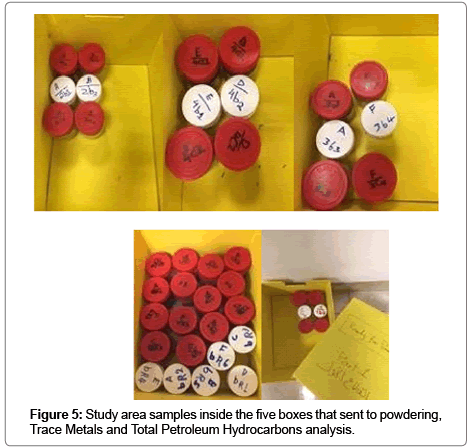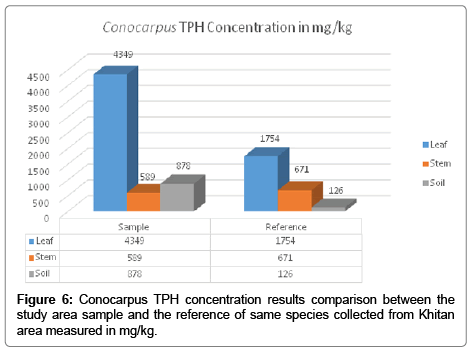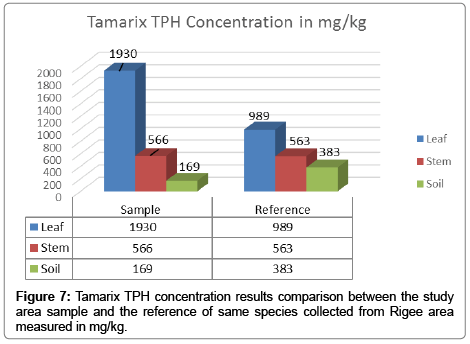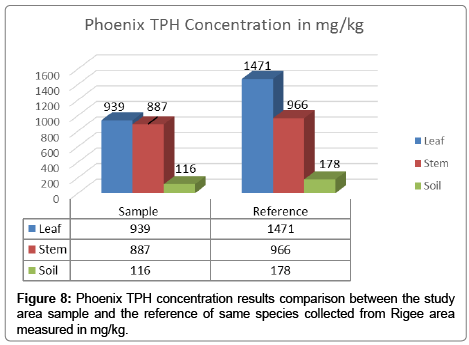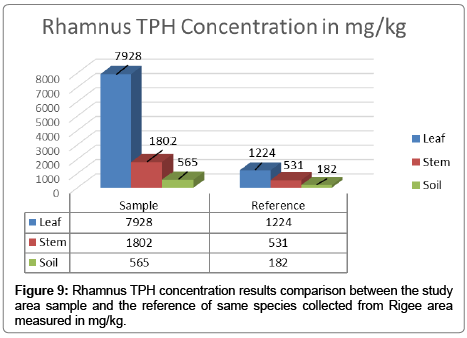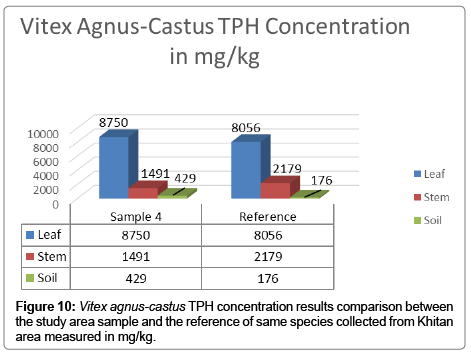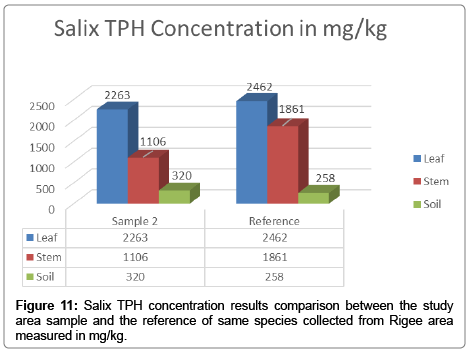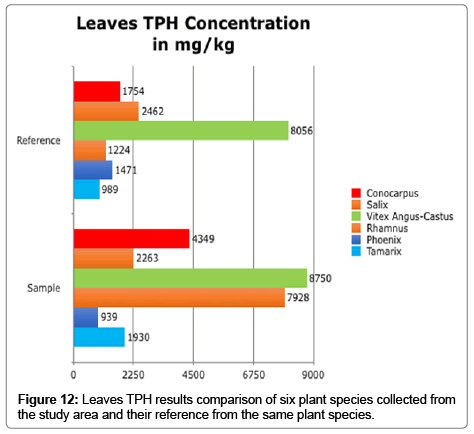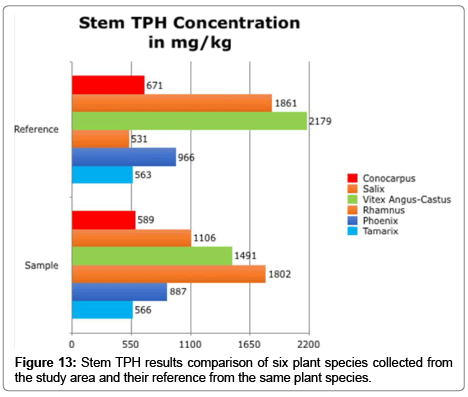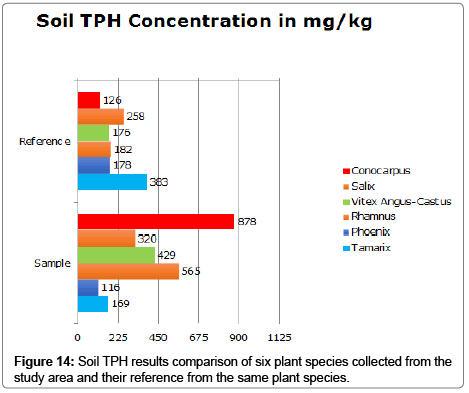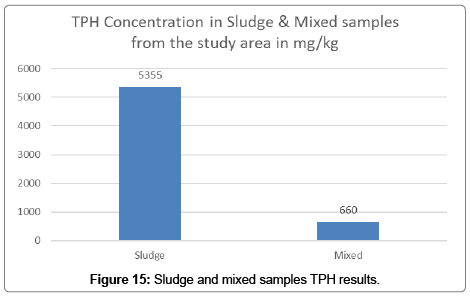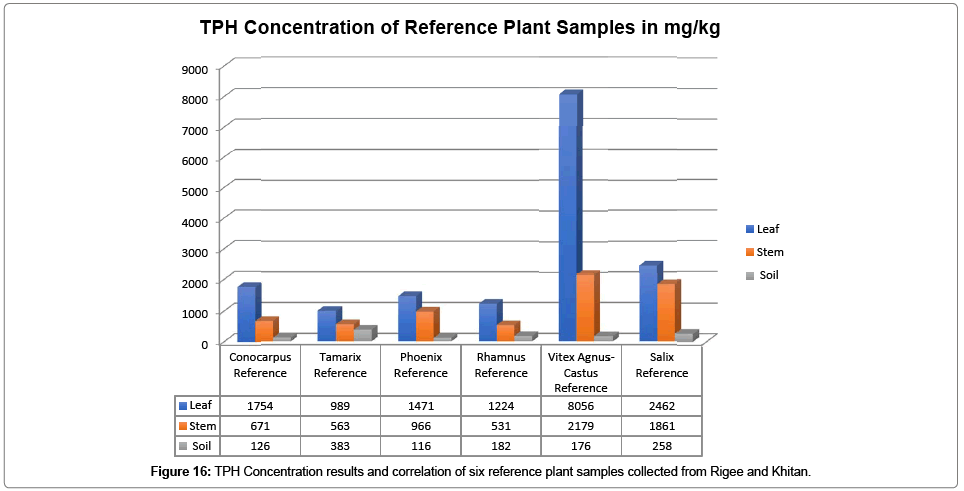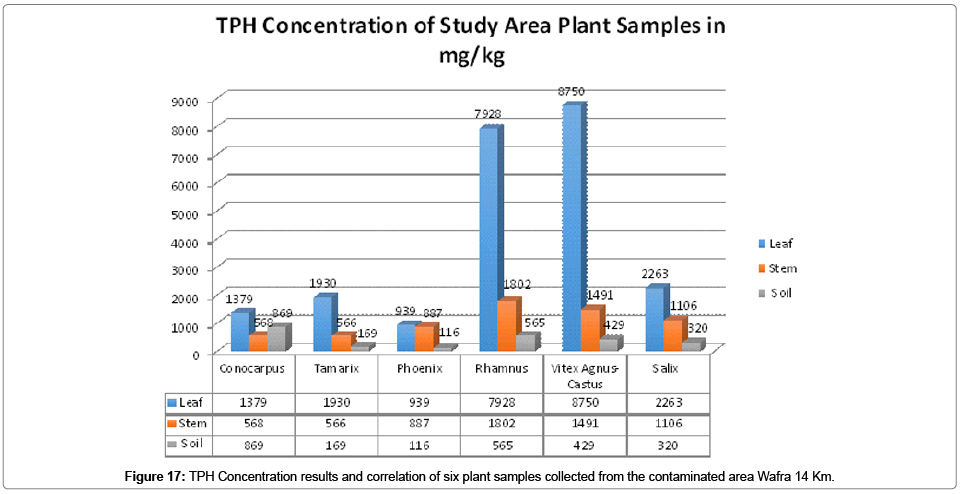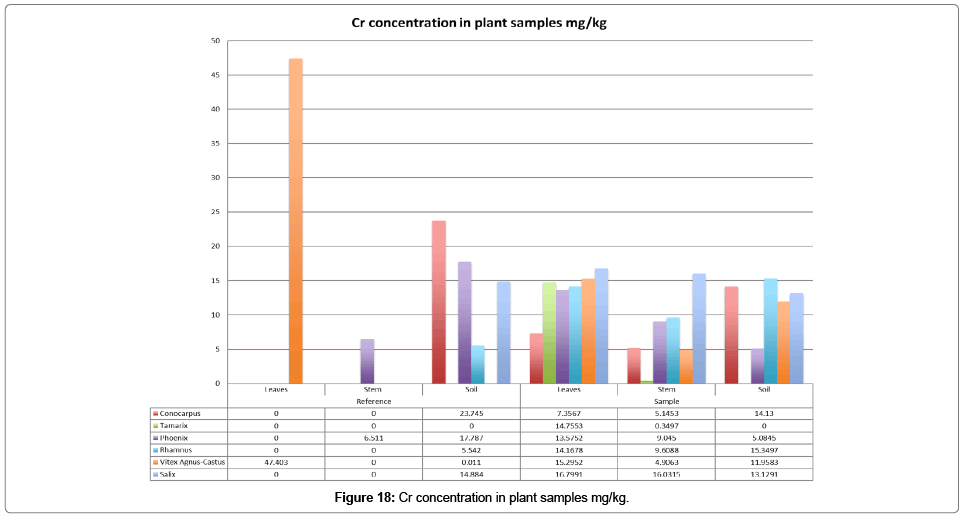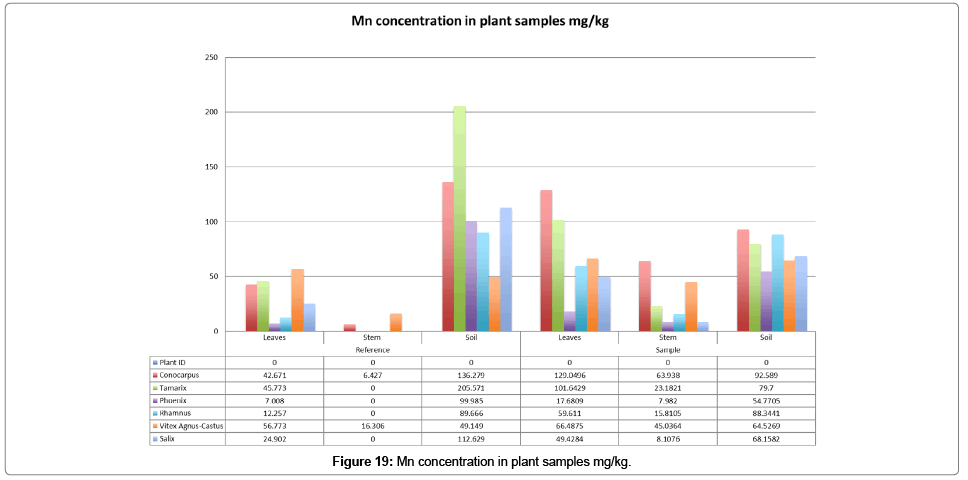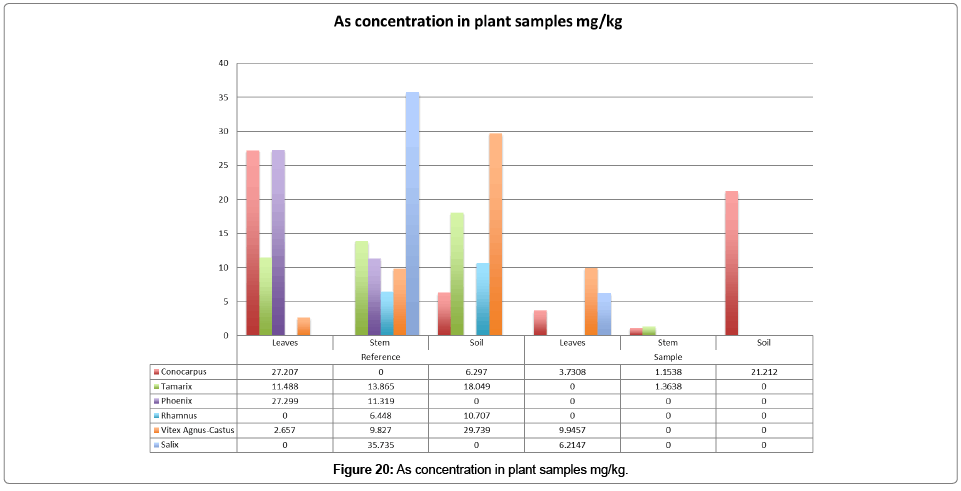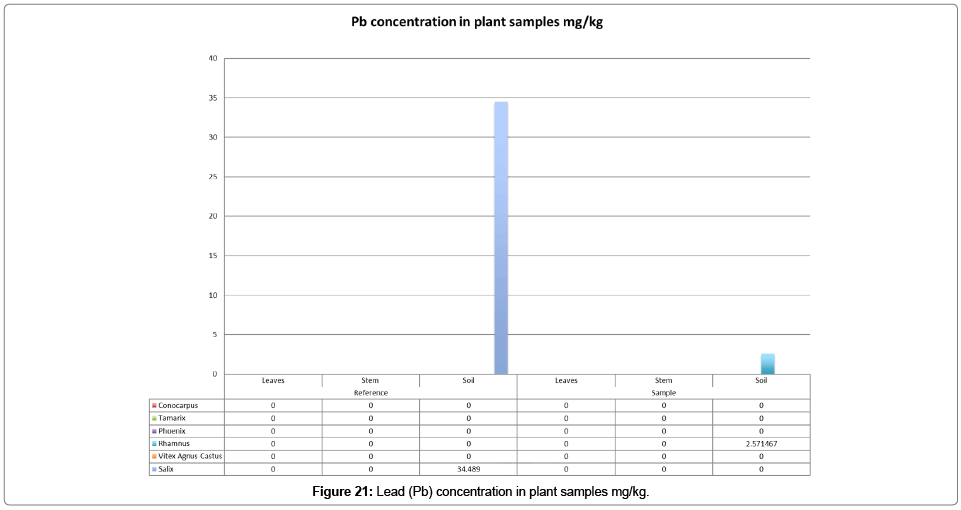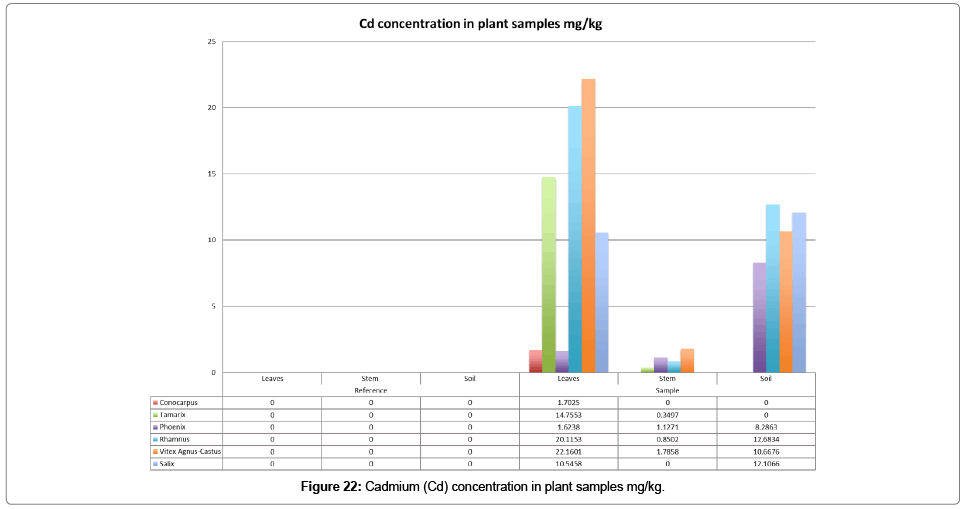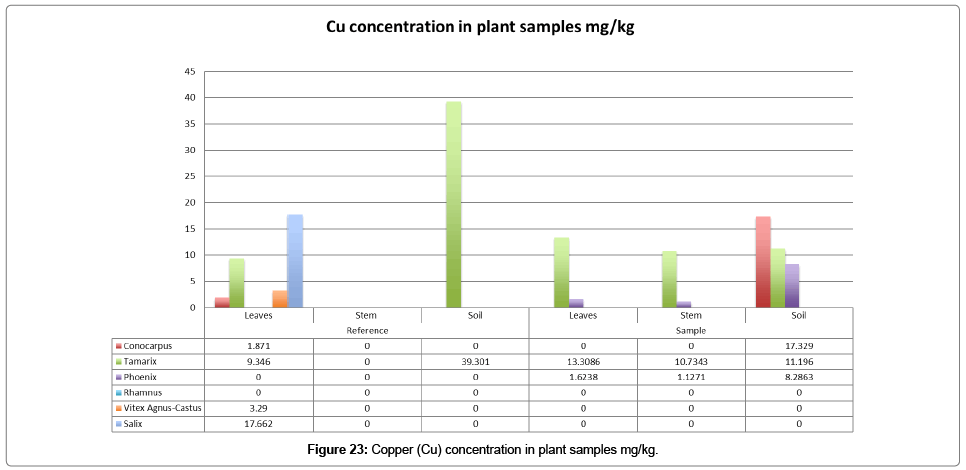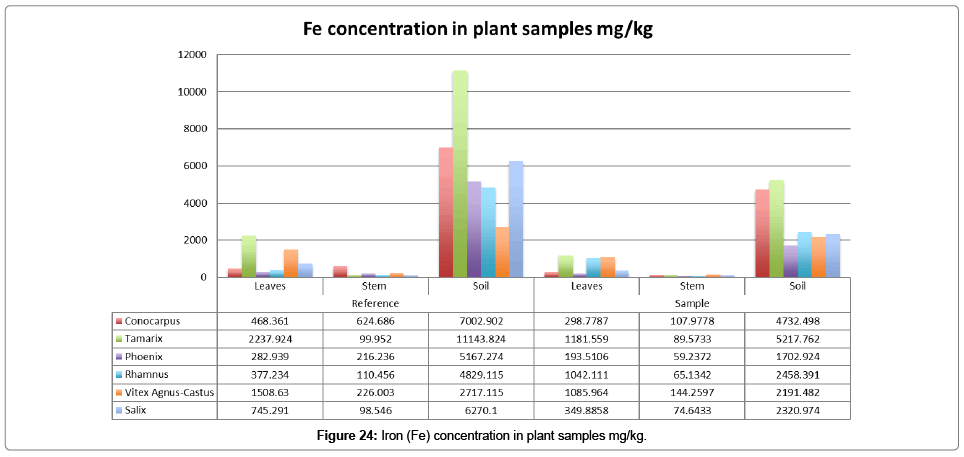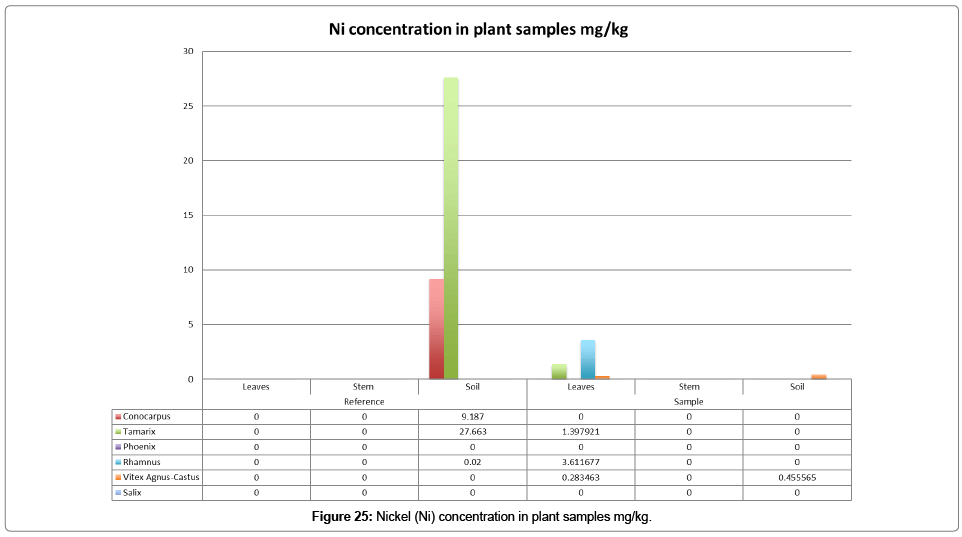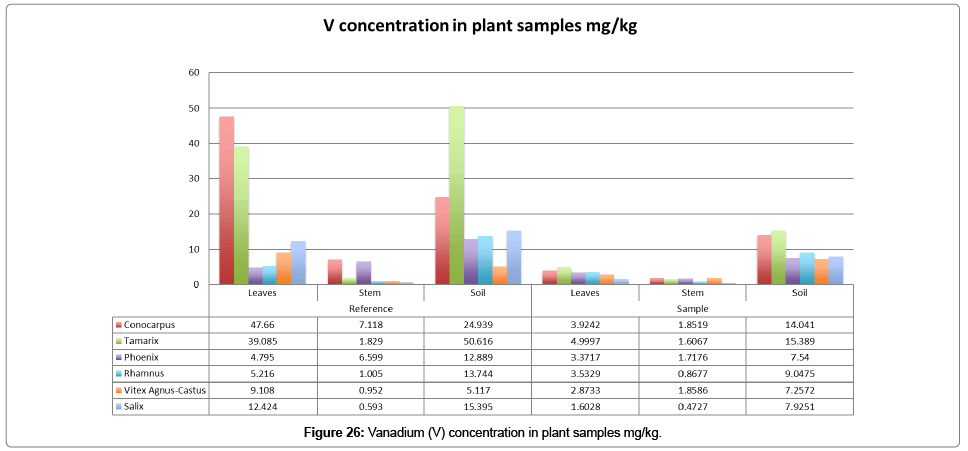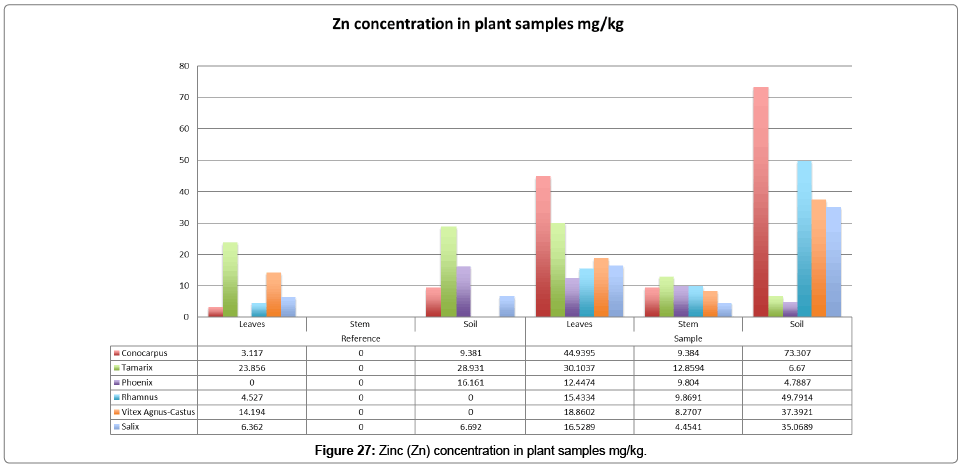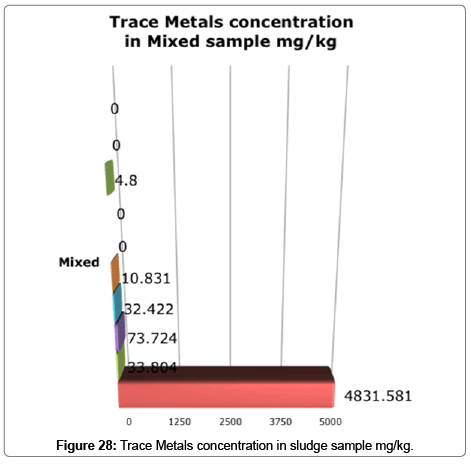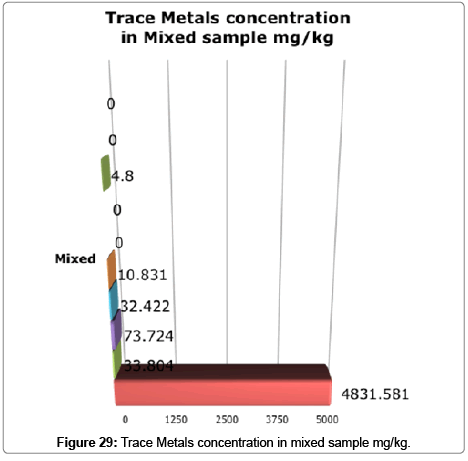Research Article Open Access
Phytoremediation for Hazardous Liquid Industrial Waste Using Six Famous Trees Species in Al Wafrah, Kuwait
Mohammad Al-Ibrahim and Al Sarawi Mohammad*
College of Science, Kuwait University, Safat, Kuwait
- *Corresponding Author:
- Al Sarawi Mohammad
College of Science, Kuwait University
Safat, Kuwait
Tel: 0096599179176
E-mail: sarawi500@gmail.com
Received Date: December 13, 2016; Accepted Date: January 09, 2017; Published Date: January 11, 2017
Citation: Al-Ibrahim M, Mohammad AS (2017) Phytoremediation for Hazardous Liquid Industrial Waste Using Six Famous Trees Species in Al Wafrah, Kuwait. J Bioremediat Biodegrad 8:378. doi: 10.4172/2155-6199.1000378
Copyright: © 2017 Al-Ibrahim M, et al. This is an open-a ccess article distributed under the terms of the Creative Commons Attribution License, which permits unrestricted use, distribution, and reproduction in any medium, provided the original author and source are credited.
Visit for more related articles at Journal of Bioremediation & Biodegradation
Abstract
Metal concentrations in soils are locally quite high in Kuwait due to many reasons such as massive oil spills during the gulf war in 1991 as well as direct dump for untreated sewage and hydrocarbon. Phytoremediation may offer a possible solution to this problem because it treats the soils through the use of plants even without the demand of removing the contaminated material and disposing it elsewhere. This research project focused on the best contribution of phytoremediating the area between six types of plant tree species collected (Conocarpus, Tamarix, Phoenix, Rhamnus, Vitex agnus-castus and Salix) from Wafra 14 Km area and another six reference trees from the same plant species collected for correlation from South Khitan and Rigee areas. The samples divided into three sample categories (leaves, stem, and soil). From the chemical analysis, it was found that phytoremediation is a unique process in reducing the level of soil contamination of hydrocarbons and trace metals. The most and effective part of the plant in accumulating hydrocarbons and heavy metals were the leaves while the appropriate plant was Vitex agnus-castus. As a recommendation, there is need for phytoextraction of heavy metals by intercropping maize plants with local agro forestry shrubs to reduce amount of heavy metals in the soil.
Keywords
Bioremediation; Phytoremediation; Hydrocarbons; Contamination; Plants
Introduction
The State of Kuwait is located on the Arabian Plate between Precambrian shield to the west and Zagros fold belt towards northeast, having an area of about 17,818 Km2 and it lies between latitudes 28°30’ and 30°05’ N, and longitude 47°30’ and 48°36’ E. Kuwait considered one of the arid regions that are primarily described by her very long period of summer season that is dry and very hot. Summer season starts from the end of March to the end of October. Between 30°C to 45°C is the range of temperature that exceeds sometimes 54°C during daytime in August. Kuwait’s winter season is short, cold and relatively wet. Winter starts from early December to mid-February [1,2].
Vegetation of Kuwait shows a great geographical variation in spite of the short distance from east to west. Variation in microclimate, relief, geomorphology, soil and land use made Kuwait vegetation cover shows a great geographical diversity. Furthermore, sedimentation of windtransported sand affected by vegetation, which plays an important role. Hence, it acts as a barrier that faces wind driven sand and changes surface morphology or roughness over large areas.
The study area is located along Wafra/Mina Abdullah road at 14 Km south of Kuwait (Figure 1). The area is about 1 Km2 and it is used to receive over than 4500 m3 daily of untreated sewage and industrial hazardous liquid waste in one of the largest unlined evaporation ponds in the state of Kuwait. The study area now is completely rehabilitated and planted by several types of plants in four main sectors comprises 45000 trees.
Recently published research has indicated that vegetation may play an important role in the bioremediation of toxic organic chemicals.
Establishing a vegetation cover on relatively polluted hazardous waste sites might be an efficient way and low maintenance method to waste remediation. Plants Usage for remediation may be especially appropriate for soil polluted by organic chemicals especially of a depth less than 2 m3. Interaction between plant roots and rhizosphere microflora significantly enhances degradation of hazardous organic compounds in contaminated soil.
Objectives
The main Objectives of this study:
• To understand the behavior of the six tree plants in absorbing pollutants.
• To study the rate of fate and flux of pollutants.
• To evaluate the leaves, stems and soils of the different six plants in cleaning the contaminated soil.
• To make a recommendation for the best out of six six tree plants selected in the study area in absorbing hydrocarbons and trace metals from contaminated soil.
Materials and Methodology
This will be achieved through:
• Determining the level of total petroleum hydrocarbon (TPH).
• Measuring Trace Metals accumulation (TM) in plant’s (leaves, stem and soil).
• Chemical comparisons between the plant samples.
Field approach
In this study six types of plant tree species were collected (Conocarpus, Tamarix, Phoenix, Rhamnus, Vitex agnus-castus and Salix) from Wafra 14 Km area and another six reference trees from the same plant species were collected for correlation from South Khitan and Rigee areas (Figure 1). The samples divided into three sample categories (leaves, stems, and soil) of each plant in the study. Therefore, the total numbers of samples collected were 44 samples including mixed treated soil and sludge one (Figures 1). Total Petroleum Hydrocarbons (TPH) and Trace Metals analysis was performed.
The fieldwork was conducted on the contaminated soil in the Wafra/Mina Abdulla road 14 Km (Figure 2). The area includes 26 samples of (leaves, stems, and soil) in addition to 18 reference samples were collected outside the contaminated area from the same species in South Khitan and Rigee areas (Figure 3).
The sediment samples were taken by shovel and packed carefully in special bags in addition to leaves and stems. Next, leaves were removed from stems to launch each analysis for each plant species and its parts separately (Figure 4). After that, Trace Metals analysis were conducted at Kuwait University while the Total Petroleum Hydrocarbons (TPH) were at Kharafi chemical laboratory.
Drying process
After classifying and dividing the 44 samples into three categories (Leaves, Stem, and Soil), the samples were separated into five boxes. Thus, four boxes include the 26 samples of four parts of study area and the fifth box contains the 18 control or reference samples of same six plant trees chosen in the study area (Figure 5).
Analysis and discussion
The use of plants for remediation may be especially well suited for soils contaminated by organic chemicals to depths of less than 2 m [3]. Thus, the interaction between plant roots and rhizosphere microflora significantly enhances degradation of hazardous organic compounds in contaminated soil. Through degradation or accumulation plants can interact with hazardous organic compounds. Uptake of pollutants in plants roots is a direct function of the contaminant amount and concentration in the solution of soil and generally contains chemical separating attached to the root surfaces took after by movement over the cortex to vascular system of plants [4]. The pollutant might be bound or digested anytime among transference. Pollutants in plants may be found as uninhibitedly extractable deposits, extractable conjugate bound to plant material, and unextractable buildups consolidated in plant tissue [3,5].
Plants may indirectly contribute to the dissipation of contaminants in vegetated soil. The utilization of plants to concentrate toxic mixes from soils (phytoextraction) is being created as a system for remediation of metal sullied soils [6,7]. Based on evidence from greenhouse and field studies, phytoremediation is a viable remediation method for petroleum-contaminated soil. The use of vegetation for remediation of contaminated sites is attractive because it is inexpensive and passive. Plants can collect trace elements; particularly trace metals, in or on their issues because of their incredible capacity to adjust to variable chemical properties of the environment: in this manner, plants are halfway supplies through which trace elements from soils, and somewhat from waters and air, move to man and creatures [8].
The main sources of trace metals to plants are the air or soil media from which trace elements are taken up by the root foliage [9]. Metals usually absorbed by plant through root uptake and are concentrated most often in the root. Although metal uptake by plant is a function of the contents of the soil, it is also affected by a plant’s inherent affinity for a given metal, which is highly controlled by plant variety and type of cultivar.
Total petroleum hydrocarbons analysis
TPH is well-defined as the quantifiable amount of petroleum-based hydrocarbon in an ecological media. It is, thus, reliant on analysis of the medium in which it is found [10]. This section explains the TPH analysis results that were conducted in the study area on different six plants species compared to similar ones from different areas as references samples. In this section we would explain the total petroleum hydrocarbons analysis of the six plants samples collected from the study area in Wafra 14 Km (Conocarpus, Tamarix, Phoenix, Rhamnus, Vitex agnus-castus and Salix).
Conocarpus
Conocarpus or Button mangrove is exceptionally adjustable as an decorative because it tolerates compressed soil, air contamination, lowly drainage, and drought [11,12]. Hence, Total Petroleum Hydrocarbons analysis (TPH) of Conocarpus samples collected from the contaminated study area and its reference from same species collected from a clean area in Khitan depicted that the leaves possessed the highest TPH value compared to stem and soil. It ranges from 4349-1754 mg/kg as shown in Figure 6.
Tamarix
Tamarix can tolerate an extreme range of environmental conditions. Genotype in saltcedar that gives it the capability to exploit a wide spectrum of habitats [13]. Total Petroleum Hydrocarbons (TPH) values of Tamarix leaves were the highest 1930-939 mg/kg whereas the stem comprises 566-563 mg/kg. Soil sample collected from the contaminated study area showed less TPH amount than the one collected as a reference from the similar species in Rigee area (Figure 7). That could be due to the stored amount of contaminants absorbed by Tamarix and stored in Leaves and stem.
Phoenix
Phoenix samples collected from the study area and Khitan as a reference of same species showed that the leaves were storing the highest amount of Total Petroleum Hydrocarbons (TPH) 939-1471 mg/kg compared to stem which ranges from 887-966 mg/kg (Figure 8). However, the Phoenix reference sample collected from Khitan area were having higher amount of TPH compared to the sample collected from Wafra 14 Km and that might be due to age of plant and the fact that the sample from the contaminated area was dead.
Rhamnus
Rhamnus Leaves of collected sample from study area stored the contaminants highly 7928-1224 mg/kg and that is proven by the low amount stored in stem and soil (Figure 9).
Vitex agnus-castus
Total Petroleum Hydrocarbons (TPH) results of study area and reference samples of the same species from Khitan showed that Vitex agnus-castus leaves stored the highest amount of TPH 8750-8056 mg/ kg compared to stem 1491-2179 mg/kg (Figure 10). But, a study of Vitex agnus-castus chemical composition states that leaves oil contained an abundance of 1,8-cineole (22.0%) [14]. Thus, that might be a cause for the high amount of TPH in leaves, further investigation needed to be study in future regarding that issue.
Salix
Planting Salix, as flora filters will ease excess nutrient uptake, decrease soil erosion, deliver habitat for many organisms above and below the water level, and improve a site’s visual features [15]. Moreover, Salix TPH analysis reveals that the leaves and stem stored efficiently the soil contaminants in the study area and reference area at Rigee. Leaves TPH ranges from 2263-2462 mg/kg whereas stem TPH ranges from 1106-1861 mg/kg (Figure 11). The reference sample showed higher amount of TPH and that could be due to its nearness of a sewage area and/or the age of plant.
Total Petroleum Hydrocarbons (TPH) Results Comparison Between Main Plant’s Structures and Soil
Leaves
This section explains TPH concentration results of the six plants species collected from the study area in Wafra 14 Km in addition to reference samples of the same species in cleaner areas. The comparison is based on leaves TPH concentration results of all the plants species. Additionally, TPH results of leaves showed that the highest value goes for Vitex angus-castus 8056-8750 mg/kg in both reference and study area samples (Figure 12).
Stem
TPH results of six plant’s stems from study area showed that the highest stored contaminants was in Rhamnus 1802 mg/kg whereas the highest one from reference samples was in Vitex angus-castus 2179 mg/ kg (Figure 13).
Soil
Soil TPH concentration results depicted that the introduced planted Conocarpus soil was having the highest amount of contaminants in the study area 878 mg/kg. Sludge sample was having a very high value of TPH 5355 mg/kg whereas the mixed or treated soil sample was 660 mg/ kg (Figures 14 and 15).
TPH results and comparison of reference plants
The TPH results comparison of six reference plant species collected from Rigee and Khitan areas indicate that Vitex angus-castus Leaves 8056 mg/kg and stem stored the highest amount of TPH 2179 mg/kg (Figure 16).
TPH results and comparison of contaminated area plants
In the contaminated study area Wafra 14 Km we found from TPH analysis conducted that the best plant could absorb and store in their leaves and stems the petroleum hydrocarbons was Vitex anguscastus (Figure 17) and that coincides too with TPH results of reference samples (Figure 16).
Trace metals analysis in plants and soil
Hyper accumulators are a small of group of plants that can take up, translocate, and stand levels of certain heavy metals that would be poisonous to any other organism [16]. Plants that can accumulate and tolerate unusually high concentrations of heavy metals in their tissue were responsible for drawing attention to the possibility of using plants in this manner. Accumulators of zinc (Zn) and nickel (Ni) for example, have been stated to include as much as 5% of these metals on a dryweight basis [17,18]. Floras collecting metals at a 5% (50,000 mg/kg) dry-weight intensity from a soil with an aggregate metal convergence of 5000 mg/kg brings about a 10-fold bio-accumulation issue. On the off chance that the plant makes a lot of biomass while gathering high fixations, an essential measure of metal can be dispensed with from the dirt by plant accumulation. Using established agricultural practices; the metal-rich plant material can be collected and removed from the site without the damage or loss of topsoil associated with old-style remediation methods. The biomass can then be reused to regain the metals that may have an economic importance. The metal bioaccumulation and focus in the plant shoots over that of the soil fixation coupled coupled with following biomass abatement methodologies can extraordinarily lessen the measure of contaminated material obliging transfer contrasted with soil dig or excavation. Plants are willing to absorb a quantity of elements from soil, some of which have no recognized biological purpose and some are known to be lethal at low concentrations. Plants growing in a contaminate environment can collect trace elements at high concentrations causing a serious danger to individual health. The uptake of metal concentration root by roots depends on speciation of metal and soil types and kind of plant species [9].
In this section we would explain the chemical analysis for each element in the six plants samples collected from the study area in Wafra 14 Km (Conocarpus, Tamarix, Phoenix, Rhamnus, Vitex agnus-castus and Salix):
Chromium (Cr): A remarkable metal for being profoundly impervious to oxidation is Chromium, even at high temperatures. Its abundance rank is the sixth element in the earth's crust, where it is consolidated with iron and oxygen as chromite mineral. It is used in businesses, for example, (metallurgical, chemical, and refractory). Hence, they are considered to be the most significant industrial sources of chromium in the atmosphere [19]. Chromium (Cr) concentrations in study area soil samples are ranging from 5.0845-15.3497 mg/kg, stem samples 0.3497-16.0315 mg/kg and leaves samples 7.3567-16.7991 mg/ kg. The highest level of Cr recorded storage in leaves goes for Salix 16.7991 mg/kg whereas the lowest is Conocarpus 7.3567 mg/kg. The highest Cr recorded in stems of study area samples was Salix 16.0315 mg/kg and the lowest is Tamarix 0.3497 mg/kg. The lowest Cr soil level of study area sample detected is of Tamarix and the highest one is of Rhamnus 15.3497 mg/kg (Figure 18). The estimated permissible limit for Cr in plants is 1.5 ppm (mg/g).
Manganese (Mn): Manganese is pure in its nature and form. Also it is a naturally occurring metal that is distinguished often by its silver color with no taste or smell. Manganese is usually found in the environment as a compound with elements such as sulfur, oxygen, or chlorine. Manganese is a vital supplement, required in trace amounts for human wellbeing. While adverse developmental effects due to insufficient (too low) levels of manganese in the diet have been evaluated. Exposure or having high dosage and concentrations of manganese can be harmful to health.
Manganese has two forms in the environment. Inorganic manganese compounds are used in the manufacture of steel, batteries, ceramics, and nutritional supplements. Manganese (Mn) concentration in study area soil sample ranges between 54.7705-92.589 mg/kg while the reference soil sample collected from Khitan and Rigee ranges from 49.149-136.279 mg/kg. Manganese concentration of stem sample collected from study area ranges from 7.982-63.938 mg/kg whereas the reference stem sample is ranging from 6.427-16.306 mg/kg. Leaves sample from study area indicates that the Mn concentration ranges from 17.6809-129.0496 mg/kg compared to reference leaves sample that gave us a range between 7.008-56.773 mg/kg. Thus, the lowest level of Mn concentration recorded in leaves sample of study area is of Phoenix compared to the highest level recorded for Conocarpus 129.049 mg/ kg. Stem sample collected from study area showed that the lowest Mn concentration recorded is of Phoenix 7.982 mg/kg whereas the highest one is of Conocarpus 63.938 mg/kg. Additionally, the lowest level detected of Mn concentration in leaves sample collected from Wafra 14 Km is of Phoenix 17.6809 mg/kg but, the highest one is of Conocarpus 129.0496 mg/kg (Figure 19). According to WHO, the concentration of Mn in terrestrial plants tend to range from 20 to 500 mg/kg.
Arsenic (As): Arsenic has been recognized in no less than 1,149 of the 1,684 perilous waste destinations that have been proposed for incorporation on the EPA National Priorities List (NPL) in the United States [20]. Moreover, Arsenic is widely distributed in the Earth's crust, which contains about 3.4 ppm arsenic [21]. Arsenic found in soil either regularly happening or from anthropogenic discharges structures insoluble buildings with iron, aluminum, and magnesium oxides found in soil surfaces, and in this structure, arsenic is moderately fixed. Nonetheless, under lessening conditions, arsenic can be discharged from the solid phase, bringing about soluble mobile types of arsenic, which might conceivably filter into groundwater or result in overflow of arsenic into surface waters. The maximum acceptable limit for agricultural soil is of 20.0 mg/kg G1 as recommended by the European Community and WHO [22].
Arsenic (As) concentration in study area soil samples was higher the permissible limit in Conocarpus soil 21.212 mg/kg where as in reference sample was above the permissible limit of 20 mg/kg in Vitex agnus-castus soil of about 29.739 mg/kg. The reference samples showed higher As concentration compared to study area samples. Hence, leaves samples of reference plant species ranges from 2.657-27.299 mg/ kg whereas the stem reference sample is ranging from 6.448-35.735 mg/kg. Thus, the increase of As concentration of reference samples might be due to the nearness of reference plants from a sewage pipe. The lowest As concentration recorded in study area leaves samples is of Conocarpus 3.7308 mg/kg and the highest is of Vitex agnus-castus leaves sample with a value of 9.9457 mg/kg (Figure 20).
Lead (Pb): Lead occurs naturally in the Earth's crust and is a heavy with high density, low melting, bluish to gray or bluish-gray metal. Yet, it is hardly discovered naturally as a metal. It is usually found mutual with two or more other elements to produce and form lead compounds. Lead today is mostly “secondary” and obtained from lead-acid batteries. It is reported that 97% of these batteries are recycled. The Pb concentration in plant samples is below detection limit except the soil samples of reference that has 34.489 mg/kg of Salix species and study area sample that has 2.57 mg/kg in Rhamnus soil sample. The increase of Reference sample Pb concentration might be due to its nearness from a sewage pipe (Figure 21).
Cadmium (Cd): Cadmium is associated with zinc, lead, and copper ores. It is a metal, which is found in the earth’s crust. The pure one is soft, silver-white metal. The soluble form of Cadmium in water is Cadmium chloride and cadmium sulfate. Cadmium is used for the following: batteries (83%), pigments (8%), coatings and plating (7%), stabilizers for plastics (1.2%), nonferrous alloys, photovoltaic devices, and other uses (0.8%). It is released to soil, water, and air by non-ferrous metal mining and refining, manufacture and application of phosphate enrichers, fossil fuel burning, and waste incineration and disposal. Cadmium can assemble in aquatic organisms and farming harvests. Its compounds may go through soil, yet its versatility relies upon various factors, for example, measure of organic matter and pH, which will shift relying upon the local environment. Ordinarily, it ties strongly to organic matter where it will be relentless in soil and be taken up by vegetation, in the end, entering the nourishment supply.
The concentration of Cadmium in study area soil samples ranges from 8.28-12.6834 mg/kg whereas the stem ranges from 0.3497-1.78 mg/kg. Moreover, leaves plant samples Cd concentration ranges from 1.6-22.16 mg/kg. The maximum level recommended by World Health Organization (WHO) in medicinal plants is 10 mg/kg. However, the leaves samples indicate that three plants species (Salix 10.5458 mg/ kg, Tamarix 14.7553 mg/kg and Vitex agnus-castus 22.16 mg/kg) had higher Cd concentration more than the permissible level mentioned earlier (Figure 22). The highest Cd concentration found stored in leaves samples is of Vitex agnus-castus 22.16 mg/kg whereas the lowest one is for Phoenix 1.623 mg/kg.
Copper (Cu): The concentration of Copper (Cu) in stem plant samples of study area was ranging from 8.28-17.329 mg/kg whereas leaves samples of study area ranges from 1.62-13.308 mg/kg (Figure 23). The maximum permissible limit for Cu in vegetables is 50 mg/kg [9,23]. In the earth's crust the average concentration is about 50 parts copper per million parts soil (ppm) or 50 grams of copper per 1,000,000 grams of soil (1.8 ounces or 0.11 pounds of copper per 2,200 pounds of soil). Copper found in all plants and animals. It is a crucial component for all perceived living creatures including people and different creatures at low ranks of consumption. At much more higher amounts, harmful impacts can happen.
The present study finds that the lowest Copper concentration is of stem sample collected from study area is of Phoenix 1.1271 mg/kg and the highest one is of Tamarix 10.7343 mg/kg. Also, it indicates that the lowest Cu concentration of leaves plant parts collected from study area goes for Phoenix 1.6238 μg/kg yet, the highest one is Tamarix 13.3086 mg/kg. The soil concentration of Cu ranged between 8.2863-17.329 mg/ kg that is below the permissible limit is 36 mg/kg according to Dutch Standards (Figure 23).
Iron (Fe): Iron is containing 4.6% of igneous rocks and 4.4% of sedimentary rocks and is frequently or regularly occurring metal [24]. Iron classic concentrations in soils is between 0.2%-55% (20,000 to 550,000 mg/kg), [25] and that can differ considerably, even in localized areas because of soil diversity and availability of other sources. However, there is no limit for Fe concentration in soil as a study indicated [26]. Iron (Fe) concentration in soil samples collected from study area ranged between 1702.9-5217.7 mg/kg. Fe concentration in stem of study area collected samples is ranging from 59.23-144.259 mg/kg where as the leaves samples ranged between 193.5-1181.559 mg/kg. According to Jones et al., the concentration of Fe in dry plant tissue was 20000- 250000 mg/kg.
The least level of Fe concentration in stem plants samples collected from study area is of Phoenix 59.23 mg/kg whereas the highest one goes to Vitex angus-castus 144.259 mg/kg. This present study indicate that the best plant stored Fe in Its leaves is Tamarix 1181.559 mg/kg and the least level detected is of Phoenix 193.31 mg/kg. Finally, the control or reference sample taken might be affected by its nearness from sewage pipe. Thus, we can notice the high percentage of Iron metal more than the study area soil (Figure 24).
Nickel (Ni): Nickel appears naturally in soils as due to weathering of the parent rock [27]. Pure nickel is a hard, shiny white metal, which has properties that make it extremely attractive for alloyed with different metals to structure mixtures called alloys. A portion of the metals that nickel can be alloyed with are iron, copper, chromium, and zinc. These combinations are utilized as a part of making metal coins and adornments and in industry for making things, for example, valves and warmth exchangers. Most nickel is utilized to make stainless steel. There are additionally mixes comprising of nickel joined with numerous different components, including chlorine, sulfur, and oxygen. Soil nickel concentrations vary widely, ranging from 0.7 to 259 mg Ni/kg soil on a global basis according to World Health Organization. In our study area the Ni in leaves samples is ranging from 1.397-3.611 mg/kg (Figure 25). This study shows that the best plant could absorb and store Ni in its leaves is Rhamnus 3.611 mg/kg.
Vanadium (V): Vanadium occurs naturally and is widely distributed in the earth’s crust at an average concentration of about 100 mg/kg. Vanadium Pollution of soil may occur whenever coal bi-products are unintentionally discharged [8]. Vanadium can be a gray-white metal or light gray or white shiny powder. Pure vanadium is a bright white, soft, and ductile metal depending on its form.
Surprisingly, the soil samples from control or reference area showed higher Vanadium amount ranged between 5.117-50.616 mg/kg whereas the soil samples collected from study area ranged between 7.25-15.389 mg/kg. Stem samples analysis of reference area showed that the range of Vanadium is between 0.593-7.118 mg/kg whereas the study area sample ranged between 7.54-15.389 mg/kg. The leaves samples of Vanadium concentration contributed the best in storing the highly contaminants in both reference and study area samples as it is shown in Figure 26. The range of leaves samples in reference area is 4.795-47.66 mg/kg whereas the study area samples showed a range of Vanadium concentration between 1.6028-4.999 mg/kg. The least level recorded is of Salix 1.6028 mg/kg in study area leaves samples yet; the highest one is of Tamarix 4.999 mg/kg. Moreover, the leaves samples in reference area had the least level in Phoenix 4.795 mg/kg and the highest V recorded value is of Conocarpus 47.66 mg/kg (Figure 26).
Zinc (Zn): One of the most common elements in the Earth's crust is Zinc. It can be found in different places such as air, water, and soil in addition to food. Zinc characteristics is elemental (or metallic) form, its color is a bluish-white, glittery metal. Zinc may burst into flame and it is powder is if stored in damp places. Metallic zinc has many uses in industry. Most well known uses of it is to coat steel and iron as well as other metals to avoid rust and corrosion and that named as galvanization process. To form alloys, metallic zinc is also mixed with other metals such as brass and bronze. It is also used to produce dry cell batteries.
Chlorine, oxygen, and sulfur, can be merged with Zinc and other elements, to create zinc compounds. It might found at dangerous waste spots. Zinc compounds are zinc chloride, zinc oxide, zinc sulfate, and zinc sulfide. They are considered to be metal placed naturally in the environment as zinc sulfide. It is usually utilized in manufacturing. White paints, ceramics, and other products are made from Zinc sulfide and zinc oxide.
The concentration of Zinc in soil samples collected from study area ranged between 4.788-73.307 mg/kg whereas the permissible limit of Zinc 10-50 of human consumption [1]. Zinc Concentration in leaves samples collected from study area ranged between 12.44-44.93 mg/kg (Figure 27). The least level of Zn concentration stored in stem is of Salix 4.45 mg/kg and the highest one is of Tamarix 12.85 mg/kg. This present study shows that the least zinc concentration in leaves samples is of Phoenix 12.44 mg/kg whereas the highest one is of Conocarpus plant species 44.93 mg/kg.
Sludge and mixed soil samples trace metals chemical analysis
Sludge soil sample showed very high amount of trace metals contamination compared to the mixed soil (treated) that is used in Wafra 14 Km for initial treatment. For instance, the values of (Cr 17.327 mg/kg, V 16.026 mg/kg, Zn 378.55 mg/kg) in the sludge is more than the mixed sample (treated) that showed (Cr 4.8 mg/kg, V 10.831 mg/kg, Zn 32.422 mg/kg) (Figures 28 and 29).
This study shows that the soil samples collected from each plant species in the study area were phytoremediated and had fewer amounts of trace metals significantly in Cr of Rhamnus soil 15.3497 mg/kg whereas the sludge is 17.327 mg/kg. Zinc (Zn) soil sample too was showing a decrease from the sample taken in most plant species significantly in Conocarpus species 73.307 mg/kg whereas the sludge was 378 mg/kg. Refer to Table 1.
| Sludge | Mixed | ||||
|---|---|---|---|---|---|
| Fe | 7808.491 | Fe | 4831.581 | ||
| As | <0.001 | As | 33.804 | ||
| Mn | 97.585 | Mn | 73.724 | ||
| Zn | 378.755 | Zn | 32.422 | ||
| V | 16.026 | V | 10.831 | ||
| Cd | <0.0005 | Cd | <0.0005 | ||
| Cu | 92.582 | Cu | <0.0005 | ||
| Cr | 17.327 | Cr | 4.8 | ||
| Ni | <0.002 | Ni | <0.002 | ||
| Pb | <0.0005 | Pb | <0.0005 | ||
Table 1: Sludge and mixed soil samples Trace Metals analysis in mg/kg.
Conclusion
Total Petroleum Hydrocarbons and Trace Metal’s chemical analysis of this research study for the six types of plant tree species collected (Conocarpus, Tamarix, Phoenix, Rhamnus, Vitex agnus-castus and Salix) shows that the concentration of Total Petroleum of Hydrocarbons is very high. Therefore, it exceeds the standard levels assigned by the environmental and authorized institution. Moreover, the concentration of conducted trace metals analysis in plant and soil depicted sometimes high variation than the permissible limits of many trace metal elements.
Total Petroleum Hydrocarbons analysis (TPH) in this research study shows that the best part absorbed and stored the contaminants is the leaves. Vitex agnus-castus species leaves got the highest storage of TPH in the study area samples, which shows 8750 mg/kg and even in the reference one about 8056 mg/kg yet, the lowest is Phoenix leaves with TPH value 939 mg/kg. Stems samples TPH analysis revealed that the highest TPH storage is of Rhamnus and the least one is Tamarix 566 mg/kg in the study area 1802 mg/kg. However, TPH analysis of soil samples collected from the study area showed that the least plant could absorb the contaminants from soil got the highest value of TPH, which is Conocarpus species which shows 878 mg/kg.
It is found in this research study of trace metals (Cr, Fe, As, Mn, V, Zn, Cu, Cd, Pb and Ni) analysis results and interpretation that the best plant parts absorbed and stored the Trace Metals mostly is the leaves.
Recommendations
From the research study the following recommendations should be followed:
• Leaves show the most important part of plants in the process of phytoremediation accordingly. It should be collected quarterly and send it to an incinerator to avoid using the contaminated plant as food for animals.
• Vitex agnus-castus is one of the most suitable plants for phytoremediation.
Research on phytoremediation should be encouraged to increase the knowledge and understanding of the fate of flux of pollutants.
Acknowledgment
We would like to thank the National Unit For Environmental Research and Services, Kuwait University (SRUL01/13 ) and Florida International University.
References
- http://www.kuwait.climatemps.com/precipitation.php
- Kuwait International Airport - Meteorological Department.
- Bell RM (1992) Higher plant accumulation of organic pollutants from soils. USEPA, Risk Reduction Engineering Laboratory, United States Environmental Protection Agency, pp:1-4.
- Crowdy SH, Jones DR (1956) Partition of Sulphonamides in Plant Roots: A Factor in their Translocation. Nature 178:1165-1167.
- Bell RM, Failey RA (1991) Plant Uptake of Organic Pollutants. Organic Contaminants in the Environment 19: 189-206.
- Baker AJM, McGrath SP, Sidoli CMD, Reeves RD (1994) The possibility of in situ heavy metal decontamination of polluted soils using crops of metal-accumulating plants. Resources, Conservation and Recycling 11: 41-49.
- Raskin I, Ensley BD (2000) Phytoremediation of toxic metals: Using plants to clean up the environment. John Wiley & Sons, New York, USA.
- Kabata-Pendias A, Pendias H (2011) Trace elements in soils and plants. FL: CRC Press, Taylor & Francis Group, Boca Raton, London, UK.
- Srinivas N, Rao SR, Kumar KS (2009) Trace metal accumulation in vegetables grown in industrial and semi urban areas: A case study. Applied Ecol Environ Res 7:131-139.
- Gustafson JB, Tell JG, Orem D (1997) Selection of representative TPH fractions based on fate and transport considerations. Amherst Scientific Publishers,Los Angeles, USA 3:1-109.
- Gilman EF, Watson DG (1993) Conocarpus erectus, buttonwood. Fact Sheet ST-179. US Forest Service and Southern Group of State Foresters, Gainesville, Florida, USA.
- National Institute of Biodiversity (2002) List of specimens of Conocarpus erectus.
- Brotherson JD, Winkel V (1986) Habitat Relationships of Saltcedar (TamarixRamosissima) in Central Utah. Great Basin Naturalist 46: 535-541.
- Entry JA, Rygiewicz PT, Emmingham WH (1993) Accumulation of cesium-137 and strontium-90 in Ponderosa pine andMonteray pine seedlings. J Environ Qual 22: 742-746.
- Baker AJM, Reeves RD, Hajar ASM (1994) Heavy metal accumulation and tolerance in British populations of the metallophyte Thlaspicaerulescens J. andC. Presl(Brassicaceae). New Phytology 127: 61-68.
- Brown SL, Chaney RL, Angle JS, Baker AJM (1994) Phytoremediation potential of Thlaspicaerulescens and bladder campion for zinc and cadmium-contaminated soil. Journal of Environmental Quality 23: 1151-1157.
- EPA (1998) Toxicological Review of Trivalent Chromium. In support of Summary Information on the Integrated Risk Information System (IRIS), US Environmental Protection Agency, Washington, USA.
- HazDat (2006) Arsenic. ATSDR’s Hazardous substance release and health effects database. Agency for Toxic Substances and Disease Registry.
- Wedepohl KH (1991) Chemical composition and fractionation of the continental crust. GeologischeRundschau 80:207-223.
- Bhattacharya AC, Samal J, Majumdar M, Santra SC (2009) Transfer of Arsenic from Groundwater and Paddy Soil to Rice Plant (Oryza sativa L.): A Micro Level Study in West Bengal, India. World Journal of Agricultural Sciences 5: 425-431.
- Samara C, Tsitouridou R, Balafoutis C (1992) Chemical composition of rain in Thessaloniki, Greece, in relation to meteorological conditions. Atmospheric Environment. Part B. Urban Atmosphere 26:359-367.
- Morel F, Hering JG, Morel F (1993) Principles and applications of aquatic chemistry.John Wiley & Sons, New York, USA.
- Bodek I, Lyman WJ, Reehl WF, Rosenblatt DH (1988) Environmental Inorganic Geochemistry.Pergamon, New York, USA.
- Masona C, Mapfaire L, Mapurazi S, Makanda R (2011) Assessment of Heavy Metal Accumulation in Wastewater irrigated Soil and Uptake by Maize plants (Zea mays L.) at Firle Farm in Harare. Journal of Sustainable Development 4:132-137.
- McGrath SP, Smith S (1995) Chromium and nickel. Heavy metals in soils 7: 152-178.
- StojkoviĬ? D, GlamoĬćlija J, DžamiĬ? A, Ĭ?iriĬ? A, RistiĬ? M, et al. (2011) Chemical composition and antimicrobial activity of Vitex agnus-castus L. fruits and leaves essential oils. Food Chemistry 128: 1017-1022.
- Wani BA, Khan A, Bodha RH (2011) Salix: A viable option for phytoremediation. African Journal of Environmental Science and Technology 5: 567-571.
Relevant Topics
- Anaerobic Biodegradation
- Biodegradable Balloons
- Biodegradable Confetti
- Biodegradable Diapers
- Biodegradable Plastics
- Biodegradable Sunscreen
- Biodegradation
- Bioremediation Bacteria
- Bioremediation Oil Spills
- Bioremediation Plants
- Bioremediation Products
- Ex Situ Bioremediation
- Heavy Metal Bioremediation
- In Situ Bioremediation
- Mycoremediation
- Non Biodegradable
- Phytoremediation
- Sewage Water Treatment
- Soil Bioremediation
- Types of Upwelling
- Waste Degredation
- Xenobiotics
Recommended Journals
Article Tools
Article Usage
- Total views: 5113
- [From(publication date):
January-2017 - Apr 03, 2025] - Breakdown by view type
- HTML page views : 4088
- PDF downloads : 1025

